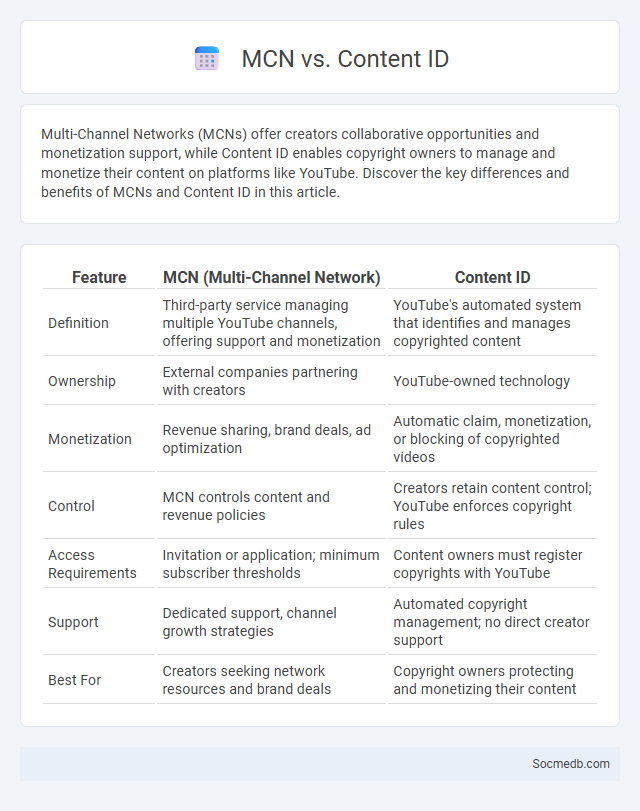
Photo illustration: MCN vs Content ID
Multi-Channel Networks (MCNs) offer creators collaborative opportunities and monetization support, while Content ID enables copyright owners to manage and monetize their content on platforms like YouTube. Discover the key differences and benefits of MCNs and Content ID in this article.
Table of Comparison
| Feature | MCN (Multi-Channel Network) | Content ID |
|---|---|---|
| Definition | Third-party service managing multiple YouTube channels, offering support and monetization | YouTube's automated system that identifies and manages copyrighted content |
| Ownership | External companies partnering with creators | YouTube-owned technology |
| Monetization | Revenue sharing, brand deals, ad optimization | Automatic claim, monetization, or blocking of copyrighted videos |
| Control | MCN controls content and revenue policies | Creators retain content control; YouTube enforces copyright rules |
| Access Requirements | Invitation or application; minimum subscriber thresholds | Content owners must register copyrights with YouTube |
| Support | Dedicated support, channel growth strategies | Automated copyright management; no direct creator support |
| Best For | Creators seeking network resources and brand deals | Copyright owners protecting and monetizing their content |
Introduction to MCN, Content ID, and MCN
Multi-Channel Networks (MCNs) serve as intermediaries between content creators and platforms like YouTube, optimizing monetization and rights management through tools like Content ID. Content ID is a digital fingerprinting system that identifies and manages copyrighted material, enabling MCNs to track usage and monetize or protect content across the platform efficiently. By leveraging MCNs and Content ID, creators enhance revenue streams, safeguard intellectual property, and scale audience engagement in the competitive social media landscape.
What is an MCN (Multi-Channel Network)?
An MCN (Multi-Channel Network) is a company that partners with multiple YouTube creators to provide support in content production, audience development, and monetization strategies. MCNs help creators optimize their channels by offering access to brand deals, cross-promotion opportunities, and advanced analytics tools. By pooling resources and expertise, MCNs enhance creators' reach and revenue potential across social media platforms.
What is YouTube Content ID?
YouTube Content ID is a digital fingerprinting system that allows copyright owners to identify and manage their content on YouTube automatically. It matches uploaded videos against a database of copyrighted material, enabling rights holders to block, monetize, or track unauthorized use. This tool helps maintain copyright compliance while allowing creators to share videos without infringing on intellectual property rights.
MCN vs Content ID: Key Differences
MCNs (Multi-Channel Networks) offer a managed partnership model providing creators with monetization support, audience growth, and content collaboration opportunities, while YouTube Content ID is an automated system that identifies and manages copyrighted material on the platform. Your choice between MCN and Content ID depends on whether you seek active management and promotional assistance or automated copyright enforcement and revenue tracking. Understanding these key differences helps optimize your social media strategy for maximizing revenue and protecting your intellectual property.
How MCNs Leverage Content ID
Multi-Channel Networks (MCNs) leverage Content ID by efficiently managing copyright claims and monetizing user-generated content across platforms like YouTube. They utilize Content ID to identify copyrighted material, enabling them to collect revenue from ads and enforce intellectual property rights. This technological integration enhances MCNs' ability to scale content distribution while protecting creators' assets and maximizing ad revenue streams.
Pros and Cons of Joining an MCN
Joining a Multi-Channel Network (MCN) on social media offers creators increased access to brand partnerships, monetization tools, and audience growth strategies tailored for platforms like YouTube and TikTok. However, MCNs often require revenue sharing, which can reduce creators' earnings, and some impose restrictive contracts that limit creative control and content freedom. Evaluating terms and potential benefits against limitations is crucial before committing to an MCN partnership.
Content ID for Independent Creators
Content ID offers independent creators powerful tools to protect and monetize their original videos across major platforms like YouTube. By automatically identifying copyrighted material, it helps you manage rights, track usage, and generate revenue from third-party uploads. Leveraging Content ID ensures your creative work maintains its value and reaches broader audiences while safeguarding against unauthorized distribution.
Revenue Sharing: MCN vs Content ID
Revenue sharing models between Multi-Channel Networks (MCNs) and Content ID systems vary significantly, impacting creators' earnings on platforms like YouTube. MCNs typically offer a revenue split ranging from 70% to 90% to creators, while managing rights, promotion, and monetization across multiple channels. Content ID enables rights holders to claim ad revenue on matched content, often resulting in passive income without direct creator involvement but with limited revenue sharing opportunities.
Choosing Between MCN and Content ID
Choosing between MCN and Content ID depends on your content distribution goals and revenue needs. MCNs offer comprehensive support, audience growth, and brand partnerships, while Content ID specializes in protecting your videos by identifying unauthorized use and generating licensing revenue. Make sure your strategy aligns with whether you prioritize content protection or enhanced monetization and reach.
Future Trends in MCN and Content ID
Future trends in Multi-Channel Networks (MCN) indicate a shift towards enhanced AI-driven analytics and personalized content strategies to maximize creator revenue and audience engagement. Content ID systems are evolving with advanced machine learning algorithms to improve copyright detection accuracy and streamline dispute resolution, benefiting both creators and platforms. Staying informed about these innovations can help you optimize content monetization and protect intellectual property effectively.
 socmedb.com
socmedb.com